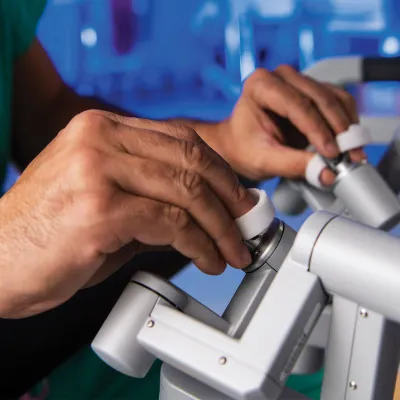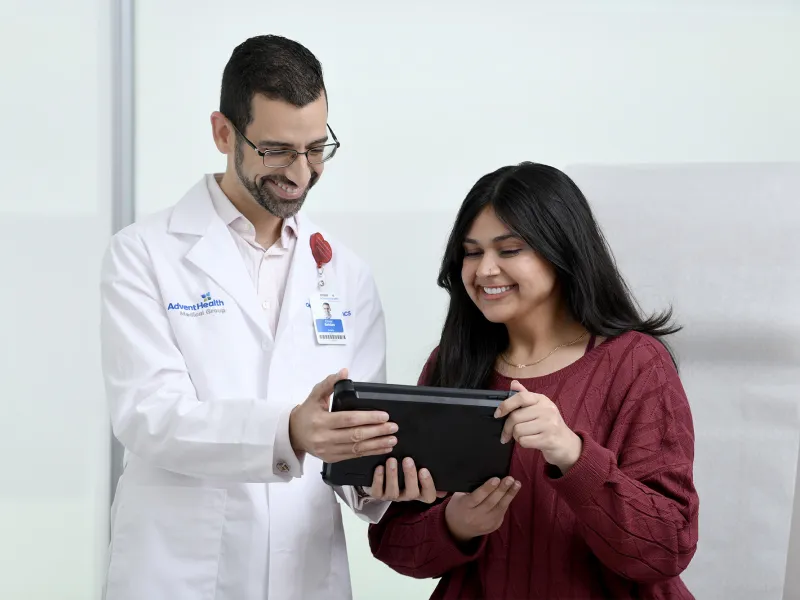
AdventHealth Digestive Health Institute Surgeons Offer Advanced Treatment Options for Achalasia, a Rare Motility Disorder
Our surgical team includes some of the most experienced surgeons in the world in using surgery to alleviate achalasia symptoms. The condition is a rare motility disorder of the esophagus that affects only about 200,000 people each year in the U.S.
Achalasia occurs when the nerve cells in the lower esophageal sphincter (LES) do not work properly. The LES is the muscle that allows food to travel from the esophagus to the stomach but not easily come back up again. When these nerve cells do not work, the esophagus spasms and contracts, and the LES relaxes unpredictably. This makes it difficult for the esophagus to push down food to the stomach as usual. The LES may prevent food from entering the stomach. People with achalasia often experience difficulty swallowing, regurgitation and chest pain. They may feel that food is getting stuck in the throat or chest.
Medical Treatment for Achalasia
Some patients with achalasia find temporary relief through medical treatment. Certain medications may be prescribed to prevent the LES and muscles of the esophagus from contracting. Another treatment is botulinum toxin A (Botox™) injections, which are given through an endoscope to paralyze the spastic LES. However, Botox treatments wear off and need to be repeated every few months. If a patient is a candidate for it, another endoscopic procedure called a pneumatic balloon dilation may be tried. This procedure opens up the LES, creating small tears in it that relax the muscle. Pneumatic balloon dilation is safe and effective and produces longer lasting results than Botox. However, dilation still only provides temporary relief and needs to be repeated.
Surgery for Achalasia: Heller Myotomy
Symptoms of achalasia can be alleviated permanently with an operation called a Heller myotomy. In this procedure, the surgeon cuts the muscle fibers of the LES. While this removes the function of the LES, food is once again able to reach the stomach without problems. So that patients do not develop acid reflux disease caused by a malfunctioning LES, AdventHealth Digestive Health Institute surgeons create a new valve using a procedure called fundoplication. It is very similar to the procedure they use to treat gastroesophageal reflux disease (GERD).
Laparoscopic Heller Myotomy with Fundoplication
One approach to treating achalasia is conventional laparoscopic surgery. This procedure involves several small incisions through which special instruments and a camera with a light are inserted to reach the surgical site. A laparoscopic approach is good for patients with severe achalasia symptoms. It often produces good results even if Botox and balloon dilation were tried and did not work.
Laparo-Endoscopic Single Site (LESS) Heller Myotomy with Fundoplication
LESS Heller myotomy is an approach that the surgeons now at DHI, together with a few others, pioneered around 2008. Because of the operation's innovative nature, Dr. Ross widely presented at conferences and wrote articles for medical journals about it. The LESS approach generally involves the same surgical plan as conventional laparoscopic Heller myotomy. However, instead of several small incisions, there is only one small incision at the umbilicus. After surgery, a patient is left with one scar hidden inside the belly button. Besides making it look as if the patient did not have surgery, LESS surgery provides reduced pain, a fast recovery and a shorter hospital stay.
Some of the World's Leading Experts in Heller Myotomy
Even though achalasia is rare, since 2008, our surgical team has undertaken hundreds of Laparo-Endoscopic Single Site (LESS) Heller myotomies. Supported by a team of skillful and experienced colleagues, Dr. Ross is believed to have the most expertise of any surgeon in treating achalasia with Heller myotomy. This approach is superior to temporary achalasia treatments and results in better cosmetic outcomes compared to conventional Heller myotomy.
To view actual footage of this surgical procedure, please visit the PROCEDURE VIDEOS.
If you or a loved one has achalasia and are wondering if surgical treatment is right for you, call Call813-615-7030 to make an appointment with a DHI surgeon.
Conditions and Treatments
-
Achalasia
The experienced surgeons at AdventHealth Digestive Health Institute offer effective and permanent treatment for achalasia. Learn more about these treatment options.
-
Acid Reflux/GERD
AdventHealth Digestive Health Institute is a regional top provider of care for acid reflux: Gastroesophageal reflux disease (GERD) and laryngopharyngeal reflux.
-
Barrett's Esophagus
The gastroenterologists and surgeons at AdventHealth Digestive Health Institute provide leading-edge treatment for Barrett’s esophagus. Learn more today.
-
Esophageal Cancer
Typically esophageal cancer requires surgery in addition to radiation and chemotherapy. Learn more about the surgical treatments our specialists can provide.
-
Esophageal Surgery
At AdventHealth Digestive Health Institute, we offer minimally invasive, robotic esophageal surgery as a cancer treatment option.
-
Swallowing Disorders
Our board-certified speech pathologist can assist patients with swallowing disorders and voice issues.
-
Upper Endoscopy / Esophagogastroduodenoscopy (EGD)
An upper endoscopy helps doctors look at the esophagus, stomach and first part of the small intestine and can help diagnose a range of conditions.

Recover Faster With Minimally Invasive and Robotic Surgery
The expert surgeons at the AdventHealth Digestive Health Institute have a large depth of experience in offering minimally invasive surgery.

Meet Your Dedicated Experts
Our specialists are passionate about providing collaborative care that addresses your unique needs and goals while ensuring you feel informed and supported every step of the way. Learn more about our team and their areas of expertise.

Surgical Consultations For Digestive Cancer Without the Wait
Appointments Within Seven Days for Patients with Cancer
At AdventHealth Digestive Health Institute, we know that after being diagnosed with cancer, patients want and often need to begin treatment quickly. So we make it a priority to offer appointments for cancer surgery consultations within five business days, and often earlier.
Patients who are newly diagnosed with cancer, or have just found out they have cancer again, qualify for this priority access. Our surgeons will make themselves available to see you right away, even for a second opinion. We want to help you start your treatment as soon as possible.
Let Us Help You Feel Whole Again
Whether you’re experiencing new symptoms or want a second opinion on a diagnosis, our dedicated digestive health experts are here to help you find answers and a path forward. Request an appointment today to take charge of your health and get the personal support you need.
